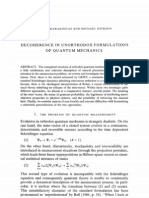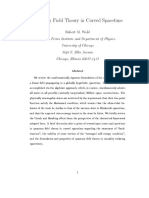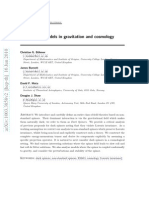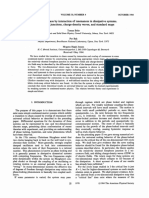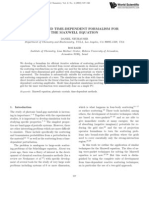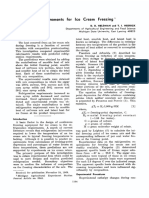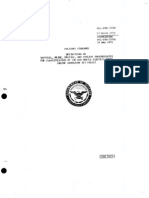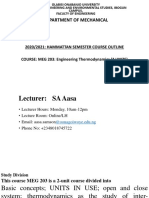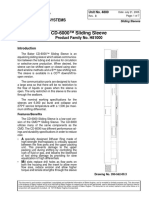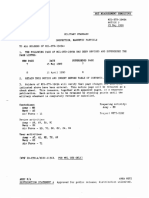Chaos in The Hodgkin-Huxley Model
Chaos in The Hodgkin-Huxley Model
Uploaded by
Richard MorrisonCopyright:
Available Formats
Chaos in The Hodgkin-Huxley Model
Chaos in The Hodgkin-Huxley Model
Uploaded by
Richard MorrisonOriginal Title
Copyright
Available Formats
Share this document
Did you find this document useful?
Is this content inappropriate?
Copyright:
Available Formats
Chaos in The Hodgkin-Huxley Model
Chaos in The Hodgkin-Huxley Model
Uploaded by
Richard MorrisonCopyright:
Available Formats
SIAM J.
APPLIED DYNAMICAL SYSTEMS c 2002 Society for Industrial and Applied Mathematics
Vol. 1, No. 1, pp. 105114
Chaos in the HodgkinHuxley Model
John Guckenheimer
and Ricardo A. Oliva
Abstract. The HodgkinHuxley model was developed to characterize the action potential of a squid axon. It has
served as an archetype for compartmental models of the electrophysiology of biological membranes.
Thus the dynamics of the HodgkinHuxley model have been extensively studied both with a view
to their biological implications and as a test bed for numerical methods that can be applied to more
complex models. This note demonstrates previously unobserved dynamics in the HodgkinHuxley
model, namely, the existence of chaotic solutions in the model with its original parameters. The
solutions are found by displaying rectangles in a cross-section whose images under the return map
produce a Smale horseshoe. The chaotic solutions are highly unstable, but they are signicant as
they lie in the basin boundary that establishes the threshold of the system.
Key words. HodgkinHuxley, chaos, action potential, horseshoe
AMS subject classications. 92C20, 37G35
PII. S1111111101394040
1. Introduction. The HodgkinHuxley model [15] for the action potential of a space-
clamped squid axon is dened by the four dimensional vector eld
v = I
120m
3
h(v + 115) + 36n
4
(v 12) + 0.3 (v + 10.599)
,
m = (1 m)
v + 25
10
4 exp
v
18
,
n = (1 n) 0.1
v + 10
10
0.125 exp
v
80
h = (1 h) 0.07 exp
v
20
h
1 + exp
v+30
10
,
(x) =
x
exp(x) 1
with variables (v, m, n, h) that represent membrane potential, activation of a sodium current,
activation of a potassium current, and inactivation of the sodium current and a parameter
I that represents injected current into the space-clamped axon. Recall that the Hodgkin
Huxley convention for membrane potential reverses the sign from modern conventions, and
so the voltage spikes of action potentials are negative in the HodgkinHuxley model. While
improved models for the membrane potential of the squid axon [3] have been formulated,
the HodgkinHuxley model remains the paradigm for conductance-based models of neural
Received by the editors August 21, 2001; accepted for publication (in revised form) by M. Golubitsky February
19, 2002; published electronically May 14, 2002. This research was partially supported by the National Science
Foundation, Department of Energy, and the ARO-EPRI Program.
http://www.siam.org/journals/siads/1-1/39404.html
Mathematics Department, Cornell University, Ithaca, NY 14853 (gucken@cam.cornell.edu, rao@cornell.edu).
105
106 JOHN GUCKENHEIMER AND RICARDO A. OLIVA
systems. From a mathematical viewpoint, varied properties of the dynamics of the Hodgkin
Huxley vector eld have been studied [13, 8, 11, 14, 16, 19, 5]. Nonetheless, we remain far
from a comprehensive understanding of the dynamics displayed by this vector eld. It has
become conventional wisdom that the qualitative properties of the HodgkinHuxley model can
be reduced to a two dimensional ow such as the FitzhughNagumo model [7]. Rinzel and
Miller [19] rst gave evidence that this is not always the case. Hassard [13] and Labouriau [16]
also studied the Hopf bifurcation that plays an important role in locating regions of bistability
in the HodgkinHuxley model. Doi and Kumagai [5] recently showed the existence of chaotic
attractors in a modied HodgkinHuxley model that changes the time constant of one of the
currents by a factor of 100. This note extends the work of Rinzel and Miller, demonstrating the
existence of chaotic solutions in the HodgkinHuxley model with the standard parameters
used by Hodgkin and Huxley.
Extensive eorts have been made to discover chaos in many physical and biological sys-
tems, including neural systems [2]. Chaotic solutions to the HodgkinHuxley equations with
periodic forcing [1] and greatly altered parameters [5] have been discovered but not in the
original HodgkinHuxley model with its original parameters. The chaotic solutions we ex-
hibit are highly unstable. We employed systematic methods to nd them as described below.
Note that, while we nd our numerical evidence for the existence of chaos in the Hodgkin
Huxley model compelling, we do not give a rigorous proof that chaos exists in this system.
The biological signicance of chaos in the HodgkinHuxley system is related to the character
of the threshold that separates states leading to repetitive ring from states that lead to a
stable steady state. We return to this issue at the end of this note. (The implications of
long-time unpredictability in deterministic chaotic systems have been widely discussed in a
broad context by Stewart [21].)
2. Evidence for chaos in the HodgkinHuxley system. A stringent denition of chaos in
a discrete dynamical system is that there is an invariant subset on which the transformation
is hyperbolic and topologically equivalent to a subshift of nite type [10, 20]. Continuous
time dynamical systems are reduced to discrete time maps through the introduction of cross-
sections and Poincare return maps [10]. We utilize the cross-section V given by a suitably
chosen value v = 4.5 to dene a Poincare return map f for the HodgkinHuxley model.
Specically, ( m, n,
h) = f(m, n, h) if the trajectory beginning at (4.5, m, n, h) next intersects
the cross-section V (with v increasing) at the point (4.5, m, n,
h). To demonstrate that f has
a chaotic invariant set, we follow the strategy described by Moser [18]. We nd two subsets
R
1
and R
2
of V and approximate splittings of the tangent bundles into stable and unstable
directions on these sets so that the following hold:
1. The derivative of f maps expanding directions close to themselves, stretching the
lengths of these vectors.
2. The sets f(R
1
) and f(R
2
) each intersect R
1
and R
2
so that their images stretch across
R
1
and R
2
in the unstable directions and intersect the boundaries of R
1
and R
2
only
on sets transverse to the unstable directions.
Using the more precise concept of invariant cone elds, Moser proved that a map f satisfying
these properties has a Smale horseshoe, a hyperbolic invariant set on which f is topologically
equivalent to the shift on two symbols.
HODGKINHUXLEY CHAOS 107
6 6.5 7 7.5 8 8.5 9 9.5 10
-100
-80
-60
-40
-20
0
20
Hopf bifurcation
S
0.6 0.7 0.8 0.9 1 1.1 1.2 1.3 1.4 1.5 1.6
x 10
5
0.5
0
0.5
1
1.5
2
2.5
3
3.5
4
4.5
(a)
(b)
v
I
log |
2
|
I 7.92197
Figure 2.1. (a) The amplitude of periodic orbits in the HodgkinHuxley model as a function of input
current. Maximum and minimum values of v are plotted for each periodic orbit. Stable periodic orbits are
shown in blue; those shown in green have a single positive unstable eigenvalue, while those shown in red have
either two unstable eigenvalues or a negative unstable eigenvalue. (b) The magnitude of the second largest
eigenvalue 2 of the return map for the periodic orbits along the vertical branch for a small interval centered
at I = 7.92197.
108 JOHN GUCKENHEIMER AND RICARDO A. OLIVA
Table 2.1
R1
m n h
0.08510711565266 0.37702513977759 0.43770368051793
0.08511751929147 0.37708261653418 0.43799786108786
0.08506722811171 0.37702247883827 0.43770500525944
0.08507763175053 0.37707995559486 0.43799918582936
0.08506795096894 0.37673045670586 0.43526697935397
0.08507180274587 0.37675541738823 0.43543828382985
0.08502806342799 0.37672779576653 0.43526830409547
0.08503191520493 0.37675275644891 0.43543960857136
R2
0.08500054963158 0.37635307899354 0.43231650435083
0.08500126298925 0.37635224747250 0.43225555564349
0.08499057463645 0.37635239912448 0.43231667147632
0.08499128799412 0.37635156760344 0.43225572276897
0.08500090973955 0.37635423427118 0.43231211561955
0.08500146426647 0.37635361157621 0.43226513798843
0.08499093474442 0.37635355440212 0.43231228274504
0.08499148927134 0.37635293170715 0.43226530511391
As a parameter of a dynamical system is varied, sets satisfying the above conditions are
frequently created through the period doubling route to chaos [6]. Rinzel and Miller [19]
located period doubling bifurcations in the HodgkinHuxley model by computing eigenvalues
along a family of periodic orbits. As the parameter corresponding to external current is
varied in the model, there is a Hopf bifurcation of steady states at I 9.78. The bifurcation
is subcritical, with a family of unstable periodic orbits collapsing to the equilibrium at the
bifurcation. Beginning at this bifurcation, we followed the family of periodic orbits using
continuation methods. Some of the observed phenomena along this family of periodic orbits
are numerically sensitive, and so we used two continuation algorithms: a collocation method
as implemented by Doedel in the program AUTO [4] and a multiple shooting method that
employs Taylor series methods and automatic dierentiation [12]. The results of the two
methods agreed with one another qualitatively.
Figure 2.1(a) plots the amplitude of the periodic orbits, showing the maximum and mini-
mum values of v for each orbit versus the parameter I for this family of periodic orbits. The
color coding corresponds to the number of eigenvalues with magnitude larger than one (blue
= 0, green = 1, red = 2 or 1 unstable negative and 1 stable negative). The orbits grow in
amplitude as I decreases from its value at the Hopf bifurcation. The branch has three turning
points, all of which are saddle-node (or fold) bifurcations of periodic orbits. The rst two
turning points reached from the Hopf bifurcation bound a short branch of periodic orbits with
two unstable eigenvalues. At the third turning point, the periodic orbits meet a family of
stable periodic orbits. The amplitude of the stable periodic orbits does not change much. On
the (red) branch S of periodic orbits, there is a parameter interval near I 7.92197 inside
which the unstable eigenvalues of the periodic orbit change dramatically. Figure 2.1(b) plots
the log of the magnitude of the real part of one of these eigenvalues. Along the at portion
at the top of this graph, the eigenvalue is complex. This allows the eigenvalue to become real
HODGKINHUXLEY CHAOS 109
Figure 2.2. Three dimensional boxes, and their images, which produce a horseshoe for the return map of
the HodgkinHuxley model. (a) The ends of box R1 transverse to the strong stable direction, and their images
are shaded in yellow with the strips mapping into R1 and R2 shaded in light blue. (b) An expanded view of the
region around R2. The ends of box R2 transverse to the strong stable direction, and their images are shaded in
red with the strips mapping into R1 and R2 shaded in light blue.
110 JOHN GUCKENHEIMER AND RICARDO A. OLIVA
and negative without becoming stable along S. A period doubling bifurcation occurs on the
part of S where the eigenvalue is negative and takes the value 1. We followed the doubled
period orbits bifurcating from S and observed that they too undergo period doubling bifur-
cations. These computations suggest the existence of a period doubling cascade; we followed
the cascade to its third period doubling. Nonetheless, these results prompted us to look for
horseshoes in the return map f for values of I slightly larger than those at which the period
doubling was found.
In the regime near the period doubling bifurcation, the periodic orbit of the family com-
puted with continuation has a negative unstable characteristic multiplier, a negative stable
characteristic multiplier, and a third positive characteristic multiplier of very small magnitude.
We investigated these periodic orbits in more detail for the parameter I = 7.8617827403. The
return map f has a xed point p
1
at the intersection of the periodic orbit with the cross-section
V . We nd that
p
1
(4.5, 0.08508337639787, 0.37698374610906, 0.43727279295129).
The sets R
1
and R
2
of our construction intersect the unstable manifold of p
1
for the return
map f. We found, as expected, that the unstable manifold has a bend. Starting in the
unstable manifold, we used a shooting method to nd a second xed point of f:
p
2
(4.5, 0.08499590453730, 0.37635277095981, 0.43229451177364).
The unstable manifold of p
1
passes near p
2
and vice-versa. Near p
1
, both unstable man-
ifolds lie close to the plane of p
1
perpendicular to the strongly contracting eigenvector. To
dene R
1
, we begin with two segments of the unstable manifolds of p
1
and p
2
near p
1
. We
enlarge the convex hull of these two segments in the plane perpendicular to the strongly con-
tracting eigenvector of p
1
to form a quadrilateral. Finally, we construct a prism with this
quadrilateral as base with edges parallel to the strongly contracting eigenvector of p
1
. The
set R
2
is obtained by an analogous procedure near p
2
. Table 2.1 gives the coordinates of the
vertices of R
1
and R
2
. Figure 2.2 shows pictures of the sets R
1
and R
2
and their images under
the return map f. (The scales of the coordinate axes in this gure are not uniform.) Each
of f(R
1
) and f(R
2
) maps across both R
1
and R
2
in the unstable direction intersecting the
boundaries of R
1
and R
2
in sets that are transverse to the unstable direction. These properties
are evidence for the existence of a Smale horseshoe in V for the return map f.
3. Biological signicance. We turn now to the signicance of these chaotic dynamics
in the HodgkinHuxley model. The chaotic invariant set located above is a highly unstable
structure associated with the threshold for action potentials. Action potentials of neurons
are large all-or-nothing voltage spikes. We specify a minimum amplitude of voltage (say,
v = 50) that must be reached to make the denition of action potential precise. In axons
that are not space-clamped, like those represented by the HodgkinHuxley model, action po-
tentials propagate along axons as traveling waves and stimulate synaptic currents in adjacent
postsynaptic neurons. Threshold is the magnitude of an input that must be exceeded for an
action potential to re. This denition of threshold is based upon the assumption that there
is a critical current input I
c
above which the axon will re an action potential when given a
brief stimulus of magnitude I
c
(with xed duration) and below which it will not. The chaotic
HODGKINHUXLEY CHAOS 111
invariant set of the HodgkinHuxley model casts strong doubt on the validity of this assump-
tion. It suggests that the boundary between initial states that lead to action potentials and
those that do not is a fractal set. Related observations about fractal basin boundaries have
been made for periodically forced neural models, for example, by Gong and Xu [9], but the
ring of an action potential does not coincide with lying in one basin of attraction or another.
There may be initial conditions leading to the ring of one or more action potentials followed
by a decay in the quiescent equilibrium state.
The concept of threshold is rarely given a precise mathematical meaning, even in the
context of models. We propose the following denition for the HodgkinHuxley model: v =
v
t
(m, n, h) is a threshold function if initial states with v > v
t
(m, n, h) yield action potentials,
while initial states with v < v
t
(m, n, h) do not produce action potentials. We conjecture that
no such function exists over a small range of steady input currents, all other model parameters
taking the values assigned by Hodgkin and Huxley. Note that this denition is formulated
in terms of initial conditions of the model with xed parameters. All of the trajectories that
appear to have local minima near the cuto v = 50 for action potentials tend rapidly to the
stable periodic orbit on their next oscillation.
The membrane oscillations within the horseshoe are intermediate in amplitude between
action potentials and the resting membrane potential of the axon. The stable branch of
periodic solutions in Figure 2.1(a) displays that the minimum of the action potentials is in
the range [100, 90] mv for a HodgkinHuxley model that res repetitively. The resting
membrane potential is near 0. (With now standard conventions for membrane potential, v
should be replaced by v
o
v for a value of v
o
55 in the HodgkinHuxley model.) Figure
3.1(a) displays two periods of the oscillations of the periodic orbits through points p
1
(blue)
and p
2
(red) and the stable periodic orbit (black). Figure 3.1(b) shows the projections of
these periodic orbits onto the (v, h) plane. Other trajectories in the horseshoe oscillate in an
irregular pattern but with amplitudes that are approximated by the amplitudes of the orbits
through p
1
and p
2
.
The stable manifolds of unstable, chaotic invariant sets often form fractal basin boundaries
of attractors in a dynamical system [17]. We conjecture that this is the case in the Hodgkin
Huxley model for the parameters used in this study; namely, the basin boundary between the
basins of attraction of the stable equilibrium and stable periodic orbit is a fractal set that
contains the stable manifold of the chaotic invariant we have discovered. Similar observations
about fractal basin boundaries have been made for periodically forced neural modelsfor
example, in the FitzhughNagumo model by Gong and Xu [9]. Initial states that lead to the
stable rest state and those that lead to the periodic ring state are interleaved. Instead of a
single sheet given by the graph of the threshold function v
t
, we expect an innite number of
layers that lead to action potentials interspersed with layers that lead to a stable steady state.
The trajectories tending to the stable steady state may show a transition with oscillations
of smaller amplitude than the action potentials. There are also uncountable sheets that lie
at threshold in the sense that they lead neither to the stable rest state nor to fully formed
action potentials, but every neighborhood contains states that lead to action potentials and
states that lead to the stable steady state. Due to the stiness of the model and the ne
scales on which the fractals appear, numerical calculation of the fractal basin boundaries of
the HodgkinHuxley model with its standard parameter values appears dicult.
112 JOHN GUCKENHEIMER AND RICARDO A. OLIVA
0 5 10 15 20 25 30 35 40 45 50
-100
-80
-60
-40
-20
0
20
-100 -80 -60 -40 -20 0 20
0.35
0.4
0.45
0.5
0.55
0.6
0.65
0.7
0.75
0.8
time
(a)
v
(b)
v
h
Figure 3.1. (a) Two cycles of three periodic orbits of the HodgkinHuxley model with external current
I = 14.2211827403. The stable periodic orbit is shown in black, and two unstable periodic orbits are shown in
red and blue. The green horizontal line is at the value v = 4.5 of the cross-section used in our computations
of a return map. (b) Projection of the three periodic orbits onto the (v, h) plane. The green segment is the
cross-section used to obtain return maps.
HODGKINHUXLEY CHAOS 113
If our conjectural description of the phase space of the HodgkinHuxley model is correct,
then there is a degree of unpredictability about how the system will respond to stimulation.
Brief current inputs to the axon that evolve to the stable steady state and those that evolve
to the ring state are nely interleaved with each other as the amplitude of the current input
is varied. The nonlinear dynamics underlying action potentials yield an inherent lack of
predictability in determining how large an input is required to cross the threshold for ring
action potentials. Due to the extreme Lyapunov exponents associated to the chaotic invariant
set, the fractal, interleaved structure of the membrane threshold is hardly observable in the
HodgkinHuxley model even in computer simulation. Inherent noise in the membrane has
a far larger scale than the fractal structure in the HodgkinHuxley model for its standard
parameters. However, we believe that the phenomenon seen here on ne scales may well
be present on larger scales in other neural systems or for dierent parameter values of the
HodgkinHuxley model. The signicance of our results is that they establish the subtlety of
the concept of threshold: the excitability of a neural membrane to re an action potential may
be more complex than a smooth hypersurface that divides subthreshold and suprathreshold
membrane potentials.
REFERENCES
[1] K. Aihara and G. Matsumoto, Chaotic oscillations and bifurcations in squid giant axons, in Chaos,
A. Holden, ed., Manchester University Press, Manchester, UK, 1986, pp. 257269.
[2] D. Campbell and H. Rose, eds., Order in chaos, Phys. D, 7 (1983), pp. 1362.
[3] J. R. Clay, Excitability of the squid giant axon revisited, J. Neurophysiol., 80 (1998), pp. 903913.
[4] E. Doedel, H. B. Keller, and J. P. Kern evez, Numerical analysis and control of bifurcation problems
I, Internat. J. Bifur. Chaos Appl. Sci. Engrg., 1 (1991), pp. 493520.
[5] S. Doi and S. Kumagai, Nonlinear dynamics of small-scale biophysical neural networks, in Biophysical
Neural Networks, R. R. Poznanski, ed., Mary Ann Liebert, Inc., Larchmont, NY, 2001, pp. 261301.
[6] J.-P. Eckmann, Roads to turbulence in dissipative dynamical systems, Rev. Modern Phys., 53 (1981),
pp. 643654.
[7] R. Fitzhugh, Impulses and physiological states in models of nerve membrane, Biophys. J., 1 (1961), pp.
445466.
[8] H. Fukai, T. Nomura, S. Doi, and S. Sato, Hopf bifurcations in multiple-parameter space of the
Hodgkin-Huxley equations, I, II, Biol. Cybern., 82 (2000), pp. 215222; 223229.
[9] P.-L. Gong and J.-X. Xu, Global dynamics and stochastic resonance of the forced Fitzhgh-Nagumo
neuron model, Phys. Rev. E. (3), 63 (2001), pp. 110.
[10] J. Guckenheimer and P. Holmes, Nonlinear Oscillations, Dynamical Systems, and Bifurcations of
Vector Fields, Springer-Verlag, New York, 1983.
[11] J. Guckenheimer and I. S. Labouriau, Bifurcation of the HodgkinHuxley equations: A new twist,
Bull. Math. Biol., 55 (1993), pp. 937952.
[12] J. Guckenheimer and B. Meloon, Computing periodic orbits and their bifurcations with automatic
dierentiation, SIAM J. Sci. Comput., 22 (2000), pp. 951985.
[13] B. Hassard, Bifurcation of periodic solutions of the Hodgkin-Huxley model for the squid giant axon, J.
Theoret. Biol., 71 (1978), pp. 401420.
[14] B. Hassard and L.-J. Shiau, A special point of Z2-codimension three Hopf bifurcation in the Hodgkin-
Huxley model, Appl. Math. Lett., 9 (1996), pp. 3134.
[15] A. L. Hodgkin and A. F. Huxley, A quantitative description of membrane current and its applications
to conduction and excitation in nerve, J. Physiol. (Lond.), 116 (1952), pp. 500544.
[16] I. S. Labouriau, Degenerate Hopf bifurcation and nerve impulse II, SIAM J. Math. Anal., 20 (1989), pp.
112.
114 JOHN GUCKENHEIMER AND RICARDO A. OLIVA
[17] S. W. McDonald, C. Grebogi, E. Ott, and J. A. Yorke, Fractal basin boundaries, Phys. D, 17
(1985), pp. 125153.
[18] J. Moser, Stable and Random Motions in Dynamical Systems, Princeton University Press, Princeton,
NJ, 1973.
[19] J. Rinzel and R. Miller, Numerical calculation of stable and unstable periodic solutions to the Hodgkin-
Huxley equations, Math. Biosci., 49 (1980), pp. 2759.
[20] S. Smale, Dieomorphisms with many periodic points, in Dierential and Combinatorial Topology (A
Symposium in Honor of Marston Morse), Princeton University Press, Princeton, NJ, 1965, pp. 6380.
[21] I. N. Stewart, Does God Play Dice?: The Mathematics of Chaos, Basil Blackwell, Oxford, UK, 1989.
You might also like
- Read Stephen Hawking's Final Theory On The Big BangDocument17 pagesRead Stephen Hawking's Final Theory On The Big BangPBS NewsHour100% (2)
- Thermal Cellular Convection Rotating Rectangular Boxes: by K.Buhler H. OertelDocument22 pagesThermal Cellular Convection Rotating Rectangular Boxes: by K.Buhler H. OertelNarendra KumarNo ratings yet
- Kazuya Koyama and David Wands - Ekpyrotic Collapse With Multiple FieldsDocument13 pagesKazuya Koyama and David Wands - Ekpyrotic Collapse With Multiple FieldsJummoeNo ratings yet
- Karakostas - Limitations On Stochastic Localization Models of State Vector ReductionDocument15 pagesKarakostas - Limitations On Stochastic Localization Models of State Vector Reductionkarakost8903100% (2)
- Chua's Circuit and The Contemporary Qualitative Theory: C. MiraDocument4 pagesChua's Circuit and The Contemporary Qualitative Theory: C. MiraAjayaKumarKavalaNo ratings yet
- Karakostas - Decoherence in Unorthodox Formulations of Quantum MechanicsDocument37 pagesKarakostas - Decoherence in Unorthodox Formulations of Quantum Mechanicskarakost8903No ratings yet
- Chuanxiu Xu Et Al - Analysis of The HO2 Vibrational Spectrum On An Accurate Ab Initio Potential Energy SurfaceDocument9 pagesChuanxiu Xu Et Al - Analysis of The HO2 Vibrational Spectrum On An Accurate Ab Initio Potential Energy SurfaceMaxnamewNo ratings yet
- 10 1 1 125 4867Document15 pages10 1 1 125 4867luanleNo ratings yet
- An Investigation of Multi-Domain Hysteresis Mechanisms Using FORC DiagramsDocument15 pagesAn Investigation of Multi-Domain Hysteresis Mechanisms Using FORC DiagramsEhsan HoseinkhaniNo ratings yet
- Aguirre 2014Document38 pagesAguirre 2014cesar abraham torrico chavezNo ratings yet
- Milne's Differential EquationDocument18 pagesMilne's Differential EquationSHareduwan KasiHmuddinNo ratings yet
- VariedadesDocument29 pagesVariedadespedronoliveira2011No ratings yet
- On Langmuir's Periodic Orbit: K. Cieliebak, U. Frauenfelder and M. SchwingenheuerDocument12 pagesOn Langmuir's Periodic Orbit: K. Cieliebak, U. Frauenfelder and M. SchwingenheuerAna España CasanovaNo ratings yet
- PhysRevLett 49 405Document4 pagesPhysRevLett 49 405tianrenxiong671No ratings yet
- Inflation With Negative Lambda 1207.6653Document4 pagesInflation With Negative Lambda 1207.6653forizslNo ratings yet
- Quantum Chaos in The Nuclear Collective Model: I. Classical-Quantum CorrespondenceDocument10 pagesQuantum Chaos in The Nuclear Collective Model: I. Classical-Quantum CorrespondenceBayer MitrovicNo ratings yet
- Journal IEEE Usman PagalayDocument5 pagesJournal IEEE Usman PagalayMukhammaFahmiNo ratings yet
- Controlling Turbulence in The Complex Ginzburg-Landau Equation - 2Document12 pagesControlling Turbulence in The Complex Ginzburg-Landau Equation - 2chenyeyuge94No ratings yet
- Tackling The Gross-Pitaevskii Energy Functional With The Sobolev Gradient - Analytical and Numerical ResultsDocument30 pagesTackling The Gross-Pitaevskii Energy Functional With The Sobolev Gradient - Analytical and Numerical ResultscocoaramirezNo ratings yet
- On Helmholtz and Higher-Order Resonance of Twin Floating BodiesDocument24 pagesOn Helmholtz and Higher-Order Resonance of Twin Floating BodiesAnonymous JEe6LWPNo ratings yet
- SWH 1 PDFDocument28 pagesSWH 1 PDFKaustubhNo ratings yet
- Heteroclinic CyclesDocument48 pagesHeteroclinic CyclesAdrian Calin MurzaNo ratings yet
- Strong-Randomness Phenomena in Quantum Ashkin-Teller Models: PACS Numbers: 75.10.Nr, 75.40.-s, 05.70.JkDocument8 pagesStrong-Randomness Phenomena in Quantum Ashkin-Teller Models: PACS Numbers: 75.10.Nr, 75.40.-s, 05.70.JkfawazNo ratings yet
- Quantum Field Theory in Curved SpacetimeDocument18 pagesQuantum Field Theory in Curved Spacetimeksva2326No ratings yet
- T'hooft Quantum Mechanics and DeterminismDocument13 pagesT'hooft Quantum Mechanics and Determinismaud_philNo ratings yet
- Altland1997-Nonstandard Symmetry Classes in Mesoscopic Normal-Superconducting Hybrid StructuresDocument20 pagesAltland1997-Nonstandard Symmetry Classes in Mesoscopic Normal-Superconducting Hybrid StructuresH LNo ratings yet
- V.A. Vladimirov, H.K. Moffatt and K.I. Ilin- On general transformations and variational principles for the magnetohydrodynamics of ideal fluids. Part 4. Generalized isovorticity principle for three-dimensional flowsDocument24 pagesV.A. Vladimirov, H.K. Moffatt and K.I. Ilin- On general transformations and variational principles for the magnetohydrodynamics of ideal fluids. Part 4. Generalized isovorticity principle for three-dimensional flowsVortices3443No ratings yet
- Wave Function...... :)Document26 pagesWave Function...... :)William Bryle PertosNo ratings yet
- 1 s2.0 0022169476901268 MainDocument23 pages1 s2.0 0022169476901268 MainAkuNo ratings yet
- David Luckhaus - From High Resolution Spectroscopy To Detailed Molecular Quantum DynamicsDocument8 pagesDavid Luckhaus - From High Resolution Spectroscopy To Detailed Molecular Quantum DynamicsMaxnamewNo ratings yet
- Jphysiol00864 0323Document21 pagesJphysiol00864 0323mohiuddin.ahmadNo ratings yet
- Factorization Algebras From Topological-Holomorphic Field TheoriesDocument51 pagesFactorization Algebras From Topological-Holomorphic Field Theorieszengwei0303No ratings yet
- (Nicolis & Prigogine, 1971) Fluctuations in Nonequilibrium SystemsDocument6 pages(Nicolis & Prigogine, 1971) Fluctuations in Nonequilibrium SystemsOscar Leonardo Aaron Arizpe VicencioNo ratings yet
- Christian G. Bohmer Et Al - Dark Spinor Models in Gravitation and CosmologyDocument43 pagesChristian G. Bohmer Et Al - Dark Spinor Models in Gravitation and CosmologyVelveetNo ratings yet
- tmp8BE4 TMPDocument9 pagestmp8BE4 TMPFrontiersNo ratings yet
- بعض المشكلات الأساسية في الميكانيكا الإحصائيةDocument30 pagesبعض المشكلات الأساسية في الميكانيكا الإحصائيةhamid hosamNo ratings yet
- Finite Element Approximation of The CahnDocument33 pagesFinite Element Approximation of The CahnMarioKunditNo ratings yet
- Chaos I N The Softening Duffing System Under Multi-Frequency Periodic ForcesDocument7 pagesChaos I N The Softening Duffing System Under Multi-Frequency Periodic ForcesBehzad BehdaniNo ratings yet
- Transition Chaos Junctions,: by Interaction Resonances in Dissipative Systems. Josephson Charge-Density and Standard MapsDocument12 pagesTransition Chaos Junctions,: by Interaction Resonances in Dissipative Systems. Josephson Charge-Density and Standard MapsaldoNo ratings yet
- Hawking 2018 Eternal InflationDocument16 pagesHawking 2018 Eternal InflationAndrés Figueroa Jiménez.No ratings yet
- 1 s2.0 S0375960116320436 MainDocument7 pages1 s2.0 S0375960116320436 MainPauloNo ratings yet
- Progress in The Analysis of Experimental Chaos Through Periodic OrbitsDocument27 pagesProgress in The Analysis of Experimental Chaos Through Periodic Orbitsbuddy72No ratings yet
- tmp6B2D TMPDocument5 pagestmp6B2D TMPFrontiers100% (1)
- Supersymmetric Quantum MechanicsDocument36 pagesSupersymmetric Quantum MechanicsBayer MitrovicNo ratings yet
- PhysRevLett 124 210605Document6 pagesPhysRevLett 124 210605Ashutosh DashNo ratings yet
- 0112039v1Document26 pages0112039v1getzemanisr1703No ratings yet
- Schnaksym 27Document34 pagesSchnaksym 27Carolina RibeiroNo ratings yet
- Topological Aspect of Disclinations in Two-Dimensional MeltingDocument6 pagesTopological Aspect of Disclinations in Two-Dimensional MeltingBayer MitrovicNo ratings yet
- Uniqueness of Complete Spacelike Hypersurfaces of Constant Mean Curvature in Gener Alized RobertsonWalker Spacetimes Gen RelatiDocument14 pagesUniqueness of Complete Spacelike Hypersurfaces of Constant Mean Curvature in Gener Alized RobertsonWalker Spacetimes Gen RelatiPaulo VicenteNo ratings yet
- Dacosta VautardDocument21 pagesDacosta Vautardbhu864No ratings yet
- Transcendental Hodge AlgebraDocument16 pagesTranscendental Hodge Algebrahuevonomar05No ratings yet
- Quantum Field Theory in Curved SpacetimeDocument18 pagesQuantum Field Theory in Curved SpacetimeAdriano Braga BarretoNo ratings yet
- Multipulse Excitability in A Semiconductor Laser With Optical InjectionDocument4 pagesMultipulse Excitability in A Semiconductor Laser With Optical Injectioncesar abraham torrico chavezNo ratings yet
- wahba1994Document19 pageswahba1994ryanNo ratings yet
- Ferenc Igloi and Heiko Rieger - Random Transverse Ising Spin Chain and Random WalksDocument17 pagesFerenc Igloi and Heiko Rieger - Random Transverse Ising Spin Chain and Random WalksPo48HSDNo ratings yet
- CS&F 22 NepDocument11 pagesCS&F 22 NephoraciowioNo ratings yet
- Vincentetal2005 MPLBDocument7 pagesVincentetal2005 MPLBlodrigaspeNo ratings yet
- Daniel Neuhauser and Roi Baer - A Two-Grid Time-Dependent Formalism For The Maxwell EquationDocument10 pagesDaniel Neuhauser and Roi Baer - A Two-Grid Time-Dependent Formalism For The Maxwell EquationPrem_SwiftNo ratings yet
- Inspection of CastingDocument23 pagesInspection of CastingRaghu Santh100% (1)
- SS Pipe Weld PurgingDocument5 pagesSS Pipe Weld Purging888ddbNo ratings yet
- Refrigeration Reqs For ICE CREAM FREEZINGDocument7 pagesRefrigeration Reqs For ICE CREAM FREEZINGJohn Robert GonzalesNo ratings yet
- Maths Question PaperDocument5 pagesMaths Question Paperhareesh.0064No ratings yet
- Thick Lens:: Optics 1 - by Dr.H.Huang, Department of Applied Physics 1Document16 pagesThick Lens:: Optics 1 - by Dr.H.Huang, Department of Applied Physics 1Shweta DixitNo ratings yet
- LIGHT Power Point PresentationDocument34 pagesLIGHT Power Point Presentationmuhammad umair100% (1)
- Mil STD 1332b Mep GensetsDocument15 pagesMil STD 1332b Mep Gensetsrsilva47No ratings yet
- Lieberman 1990Document1 pageLieberman 1990kishore dasmunshiNo ratings yet
- InterfacingDocument91 pagesInterfacingAnonymous Nlaa5HNo ratings yet
- 1st Year Phys ch1,11Document3 pages1st Year Phys ch1,11usmanbahadur121No ratings yet
- Block Diagram: 16QAM System: T T T TDocument2 pagesBlock Diagram: 16QAM System: T T T THimanshu PanchalNo ratings yet
- MEG 203 Engineering ThermodynamicsDocument77 pagesMEG 203 Engineering ThermodynamicsOyekale IniNo ratings yet
- P-752 Unit5Document3 pagesP-752 Unit5arijitdey6No ratings yet
- Paint Volume SolidsDocument7 pagesPaint Volume SolidsjasminneeNo ratings yet
- Universidad Nacional de TrujilloDocument43 pagesUniversidad Nacional de TrujilloBrais MartínezNo ratings yet
- Feedforward and Ratio ControlDocument44 pagesFeedforward and Ratio ControlsekinNo ratings yet
- Doka Large Formwork User ManualDocument21 pagesDoka Large Formwork User ManualNasir AryaniNo ratings yet
- F322 Chemistry. Chains, Energy and Resources (QP)Document16 pagesF322 Chemistry. Chains, Energy and Resources (QP)Parul BhatiaNo ratings yet
- CV Durjoy ChakrabortyDocument3 pagesCV Durjoy ChakrabortydurjoychakrabortyNo ratings yet
- Chapter 7 - Circular MotionDocument26 pagesChapter 7 - Circular Motionsheil.cogayNo ratings yet
- Notes Important Questions Answers 12th Math Chapter 3 Exercise 3.8Document6 pagesNotes Important Questions Answers 12th Math Chapter 3 Exercise 3.8shahidNo ratings yet
- Konduktometer Hannna HI2315Document11 pagesKonduktometer Hannna HI2315J FadliNo ratings yet
- Conthermo Warming ChamberDocument4 pagesConthermo Warming ChamberArstNo ratings yet
- Electrical Systems Simulation LAB MANUAL 2019-2020Document25 pagesElectrical Systems Simulation LAB MANUAL 2019-2020Vinay Kumar50% (2)
- Chemistry Honors Project 3Document3 pagesChemistry Honors Project 3api-220385579No ratings yet
- Problems303 13 SolDocument1 pageProblems303 13 SolNitish PutrevuNo ratings yet
- 4880 - TU CD-6000 Sliding Sleeve - Part.9,11,13Document7 pages4880 - TU CD-6000 Sliding Sleeve - Part.9,11,13fjflores26No ratings yet
- Mil-Std-1949a NoticeDocument3 pagesMil-Std-1949a NoticeGökhan ÇiçekNo ratings yet
- Unit 11Document19 pagesUnit 11anil.gelra5140No ratings yet






